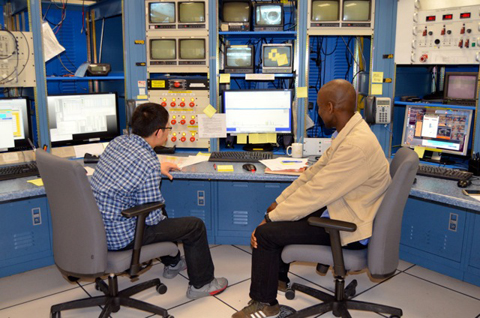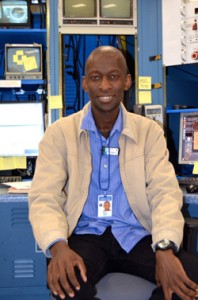
Graduate students play role as lab “sparkles its way into new era.” From left, Longwu Ou and Mongi Dlamini in the Counting House.
Physics & Astronomy graduate student Mongi Dlamini was helping April 1 when “the crown jewel of the Department of Energy’s Thomas Jefferson National Accelerator Facility sparkled its way into a new era,” as Science Daily described it.
That day will “forever remain engraved in my mind,” Dlamini says.
The accelerator’s new era began with the first step in commissioning the upgraded Continuous Electron Beam Accelerator Facility—the superconducting accelerator redesigned to more than double its energy output. The beams race around the track and are directed to targets in experimental areas called “halls,” where they are directed into the nuclei of target materials for nuclear physics experiments.
“The CEBAF accelerator delivered the highest-energy electron beams it has ever produced into a target in an experimental hall, recording the first data of the 12 GeV (gigaelectronvolt) era. The machine sent electrons around the racetrack three times (known as “3-pass” beam), resulting in 6.11 GeV electrons at 2 nanoAmps average current for more than an hour,” reports Science Daily.
Diamini and Longwu Ou, a grad student at Massachusetts Institute of Technology, were in the Hall A Counting House, where experiments are monitored as they run. When called upon, they inserted their carbon target into the beamline.
“Finally, at 10:25 p.m., the accelerator crew sent the first 6.1 GeV electrons into the experimental target and held it there for the next 75 minutes,” reports Science Daily.
“I work with Dr. Julie Roche, and we are currently at the Thomas Jefferson Lab in preparation for our upcoming experiment later this year,” Dlamini says.
“For me, being part of this exercise ranged from being educative to being emotional at the same time. Educative in the sense that I got an opportunity to work with and hence be trained by different experts—from all over the country and the world—in different aspects of lab operation.
“The emotions came from being able to experimentally set up and observe an interaction which I’ve learned so much about in my coursework, for the first time. Being part of an exercise where I had to contribute in setting up and realizing this new era at the Lab will forever remain engraved in my mind,” he says.
Mongi Dlamini’s work is supported by the National Science Foundation under Grant Award #1306376.
Read more about the next steps in the CEBAF commissioning process.




















Comments